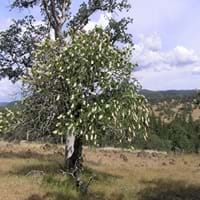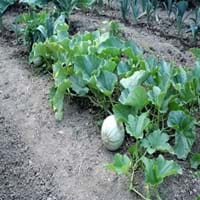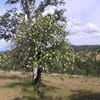Life Span
Perennial
Annual
Origin
California
Hybrid origin, Africa
Types
Not Available
C melo subsp melo
Habitat
Hillside
gardens, Temperate Regions, Terrestrial
USDA Hardiness Zone
7-9
Not Available
Sunset Zone
3a, 3b, 4, 5, 6, 7, 8, 9, 10, 14, 15, 16, 17, 18, 19, 20, 21, 22, 23, 24
2a, 2b, 3a, 3b, 4, 5, 6, 7, 8, 9, 10, 11, 12, 13, 14, 15, 16, 17, 18, 19, 20, 21, 22, 23, 24
Habit
Oval or Rounded
Vining/Climbing
Flower Color
White, Pink
Yellow
Flower Color Modifier
Bicolor
Bicolor
Fruit Color
Yellow Brown
White, Yellow, Light Yellow, Gold, Tan, Sandy Brown
Leaf Color in Spring
Light Green
Green, Light Green
Leaf Color in Summer
Green
Green, Light Green
Leaf Color in Fall
Not Available
Green, Light Green
Leaf Color in Winter
Not Available
Light Green
Plant Season
Spring, Summer, Fall, Winter
Summer, Fall
Sunlight
Full Sun, Partial Sun
Full Sun
Growth Rate
Medium
Very Fast
Type of Soil
Clay, Loam, Sand
Loam
The pH of Soil
Acidic, Neutral
Neutral
Soil Drainage
Well drained
Well drained
Bloom Time
Late Spring, Early Summer
Indeterminate
Tolerances
Drought, Salt
Drought
Where to Plant?
Ground
Container, Ground
How to Plant?
Seedlings
Seedlings, Transplanting
Plant Maintenance
Medium
Medium
Watering Requirements
Keep the ground moist but not water-logged, Requires regular watering, Requires watering in the growing season
Do Not over Water, Keep the ground moist but not water-logged, Never Over-water, Requires a lot of watering, Requires regular watering, Requires watering in the growing season, Water Deeply
In Summer
Lots of watering
Lots of watering
In Spring
Moderate
Moderate
In Winter
Average Water
Average Water
Soil pH
Acidic, Neutral
Neutral
Soil Type
Clay, Loam, Sand
Loam
Soil Drainage Capacity
Well drained
Well drained
Sun Exposure
Full Sun, Partial Sun
Full Sun
Pruning
Remove damaged leaves, Remove dead leaves, Remove dead or diseased plant parts
Remove Vines
Fertilizers
All-Purpose Liquid Fertilizer
All-Purpose Liquid Fertilizer
Pests and Diseases
Red blotch
Red blotch
Plant Tolerance
Drought
Drought
Flower Petal Number
Not Available
Single
Foliage Texture
Medium
Coarse
Foliage Sheen
Glossy
Matte
Attracts
Birds, Butterflies
Not Available
Allergy
Not Available
Abdominal pain, breathing problems, Diarrhea, Dizziness, Nausea, Vomiting
Aesthetic Uses
Beautification, Landscape Designing, Showy Purposes
Not Used For Aesthetic Purpose
Beauty Benefits
Not Available
Not Available
Environmental Uses
Air purification
Air purification
Medicinal Uses
Not Available
anti-cancer, Antioxidants, Cardiovascular problems, Combats Stress, Eye Problems, Immunity, Insomnia
Part of Plant Used
Fruits
Fruits
Other Uses
Decoration Purposes, Showy Purposes, Used as Ornamental plant
Economic Purpose, Employed in herbal medicine, Used As Food
Used As Indoor Plant
No
No
Used As Outdoor Plant
Yes
Yes
Garden Design
Dried Flower, Everlasting, Feature Plant, Hedges, Mixed Border, Screening, Wind Break
Edible, Fruit / Fruit Tree, Herb / Vegetable, Vine
Botanical Name
AESCULUS californica
CUCUMIS melo
Common Name
California Buckeye
Cantaloupe, Casaba Melon, Honey Dew, Melon, Muskmelon
In Hindi
कैलिफोर्निया Buckeye
खरबूजा
In German
California Buckeye
Cantaloup Melone
In French
California Buckeye
Cantaloup
In Spanish
California Buckeye
Cantalupo
In Greek
Καλιφόρνια Buckeye
Πεπονάκι
In Portuguese
California Buckeye
Cantalupo
In Polish
Kalifornia Buckeye
Kantalupa
In Latin
California Buckeye
cantaloupe
Phylum
Magnoliophyta
Tracheophyta
Class
Magnoliopsida
Magnoliopsida
Order
Sapindales
Cucurbitales
Family
Sapindaceae
Cucurbitaceae
Clade
Angiosperms, Eudicots, Rosids
Angiosperms, Eudicots, Rosids
Tribe
Not Available
Melothrieae
Subfamily
Hippocastanoideae
Cucurbitoideae
Number of Species
Not Available
Season and Care of California Buckeye and Cantaloupe
Season and care of California Buckeye and Cantaloupe is important to know. While considering everything about California Buckeye and Cantaloupe Care, growing season is an essential factor. California Buckeye season is Spring, Summer, Fall and Winter and Cantaloupe season is Spring, Summer, Fall and Winter. The type of soil for California Buckeye is Clay, Loam, Sand and for Cantaloupe is Loam while the PH of soil for California Buckeye is Acidic, Neutral and for Cantaloupe is Neutral.
California Buckeye and Cantaloupe Physical Information
California Buckeye and Cantaloupe physical information is very important for comparison. California Buckeye height is 460.00 cm and width 460.00 cm whereas Cantaloupe height is 20.30 cm and width 150.00 cm. The color specification of California Buckeye and Cantaloupe are as follows:
California Buckeye flower color: White and Pink
California Buckeye leaf color: Light Green
Cantaloupe flower color: Yellow
- Cantaloupe leaf color: Green and Light Green
Care of California Buckeye and Cantaloupe
Care of California Buckeye and Cantaloupe include pruning, fertilizers, watering etc. California Buckeye pruning is done Remove damaged leaves, Remove dead leaves and Remove dead or diseased plant parts and Cantaloupe pruning is done Remove Vines. In summer California Buckeye needs Lots of watering and in winter, it needs Average Water. Whereas, in summer Cantaloupe needs Lots of watering and in winter, it needs Average Water.





